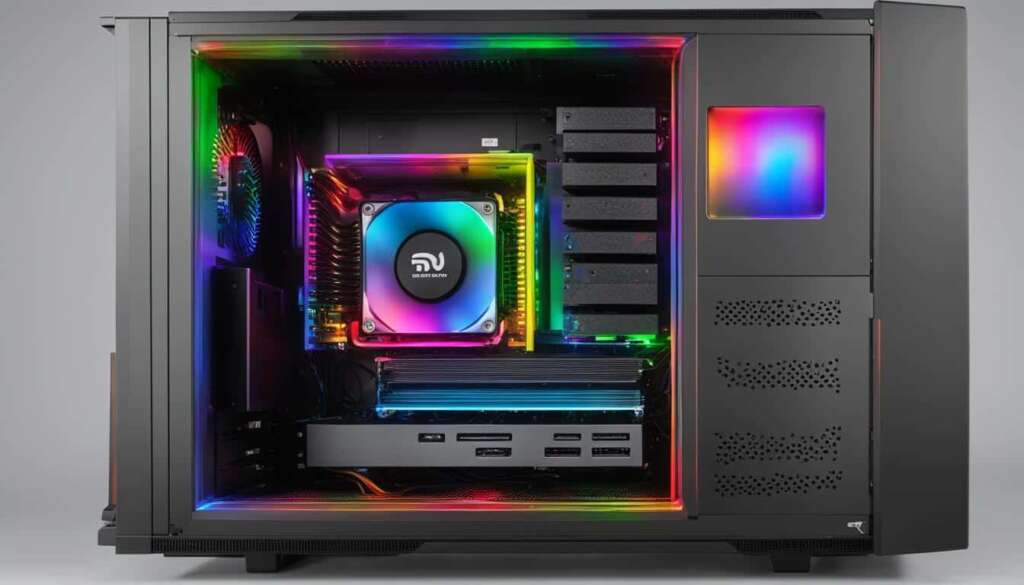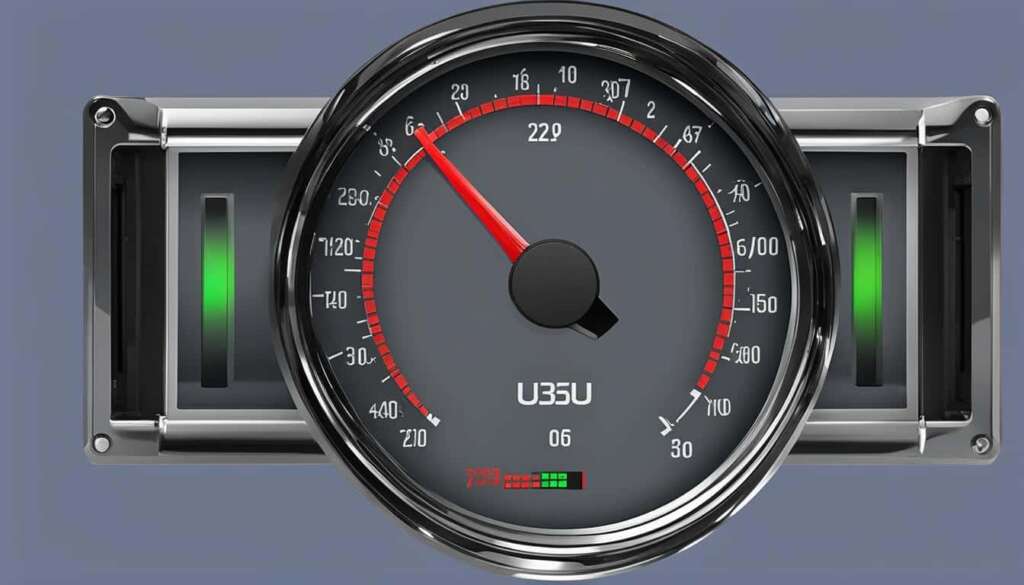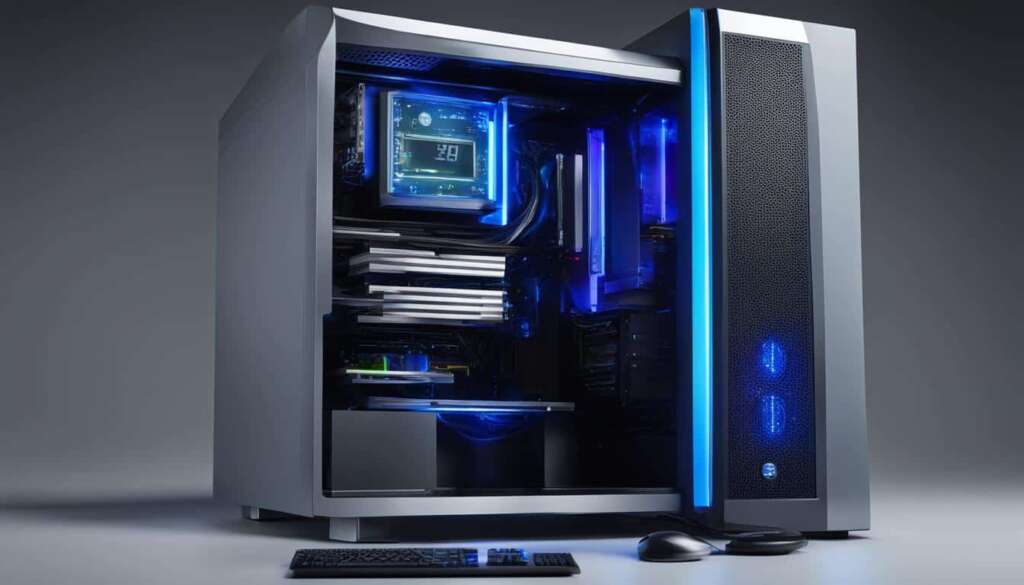Table of Contents
Monitoring the temperature of your CPU is crucial for ensuring optimal performance and longevity of your PC. Excess heat can lead to throttling of performance, decrease the lifespan of your PC, and even cause physical discomfort. While most PCs don’t have built-in temperature monitoring tools, there are several software solutions available to help you monitor your CPU temperature. In this article, we will explore the best CPU temp monitors that you can use to track your system’s health efficiently.
Key Takeaways:
- Monitoring CPU temperature is essential for maintaining PC health and performance
- Excess heat can lead to performance throttling and decreased lifespan of your PC
- Software solutions are available to monitor CPU temperature in both Windows and macOS
- Normal CPU temperature ranges can vary depending on the CPU and tasks being performed
- Regular monitoring and maintenance of CPU temperature is important for PC longevity and performance
How to Monitor CPU Temperature in Windows
Monitoring CPU temperature in Windows can be done through third-party software. One recommended software is Core Temp, which provides comprehensive information about your CPU temperature without overwhelming you with unnecessary details. It allows you to monitor temperature from the Windows taskbar, making it convenient to keep an eye on it over time.
Another option for Windows users is MSI’s BIOS/UEFI, which displays CPU and motherboard temperature. However, this method is not as consistent as using third-party software, as it requires accessing the BIOS screen and may vary depending on your specific manufacturer.
“Monitoring CPU temperature is crucial for ensuring optimal performance and longevity of your PC.”
Core Temp: A Comprehensive CPU Temperature Monitor
Core Temp is a popular CPU temperature monitoring software that provides real-time temperature readings. It offers a user-friendly interface, displaying the current temperature, load capacity, and other relevant information about your CPU.
Key features of Core Temp include:
- Minimalistic design that focuses on essential information without overwhelming the user.
- The ability to view individual core temperatures and average temperature for multi-core processors.
- Support for a wide range of CPUs from different manufacturers.
- Customizable settings to set temperature alarms and notifications.
MSI’s BIOS/UEFI: Monitoring Temperature at the Hardware Level
If you prefer monitoring CPU temperature at the hardware level, MSI’s BIOS/UEFI provides an option to check CPU and motherboard temperature. To access this feature, you need to restart your computer and enter the BIOS/UEFI screen during the boot process. However, keep in mind that the method may vary depending on your specific motherboard manufacturer.
“Regularly monitoring and maintaining optimal CPU temperature will ensure the longevity of your PC and enhance its performance.”
| Software | Pros | Cons |
|---|---|---|
| Core Temp | – User-friendly interface – Real-time temperature monitoring – Customizable settings |
– Requires installation – Limited compatibility with older CPUs |
| MSI’s BIOS/UEFI | – Hardware-level temperature monitoring – No need for third-party software – Accessible during system boot |
– Accessing BIOS screen can be complicated – Method varies across different motherboard manufacturers |
How to Monitor CPU Temperature in macOS
Monitoring CPU temperature in macOS can be done using Terminal commands. By running a specific code in the Terminal, you can view the current CPU die temperature. However, this method requires re-entering the command every time the Terminal window is closed.
Alternative Option: Fanny
An alternative option for monitoring CPU temperature in macOS is using Fanny, a free software that provides an easy-to-use interface for tracking the temperature. Fanny allows you to display the temperature in the menu bar, making it convenient to check the temperature without the need to open a separate window. This eliminates the hassle of repeatedly entering commands in the Terminal.
To use Fanny, simply download and install the software from their official website. Once installed, Fanny will start automatically and display the CPU temperature in the menu bar. You can customize the menu bar display to show temperature readings in either Celsius or Fahrenheit, depending on your preference.
Fanny also offers additional features such as fan control and temperature notifications. With fan control, you can adjust the speed of your Mac’s fan to help regulate the temperature. Temperature notifications allow you to set threshold levels, and Fanny will alert you if the CPU temperature exceeds those thresholds.
Overall, Fanny provides a user-friendly and convenient solution for monitoring CPU temperature in macOS. Its menu bar display, fan control, and temperature notifications make it an excellent choice for keeping your Mac’s temperature in check.
| Advantages of Using Fanny for CPU Monitoring in macOS | Disadvantages of Using Fanny for CPU Monitoring in macOS |
|---|---|
|
|
Best CPU Temp Monitor Tools
When it comes to monitoring the temperature of your CPU, there are several reliable tools available that offer different features and functionalities. Whether you’re a casual user or a PC enthusiast, finding the right CPU temp monitor tool is essential for maintaining the health and performance of your system.
1. Core Temp
One of the most popular software solutions for monitoring CPU temperature is Core Temp. It provides comprehensive information about your CPU temperature without overwhelming you with unnecessary details.
With Core Temp, you can monitor your CPU temperature from the Windows taskbar, making it convenient to keep an eye on it over time. It also displays other CPU-related information, such as load percentage and clock speed.
2. NZXT CAM
If you’re looking for a more advanced CPU temp monitoring tool, NZXT CAM is worth considering. It not only monitors CPU temperature but also provides real-time data on other components of your system, such as GPU temperature and fan speed.
NZXT CAM offers a user-friendly interface with customizable widgets, allowing you to create a dashboard that suits your monitoring needs. It also provides notifications and alerts when your CPU temperature exceeds a certain threshold.
3. HWMonitor
Another popular CPU temp monitoring tool is HWMonitor. It provides detailed information about your CPU temperature, as well as the temperatures of other hardware components, such as the motherboard and GPU.
HWMonitor displays temperature readings in a clear and easy-to-understand format. It also offers real-time monitoring, allowing you to track temperature changes as you perform different tasks on your PC.
4. MSI Afterburner
If you’re a gamer, MSI Afterburner is a great choice for monitoring CPU temperature. While primarily designed for overclocking your GPU, it also provides CPU temperature monitoring functionality.
MSI Afterburner allows you to display CPU temperature as an overlay while gaming, so you can keep an eye on it without interrupting your gameplay. It also offers other features like fan control and performance tuning.
| Tool | Features |
|---|---|
| Core Temp | – Real-time CPU temperature monitoring – Displays load percentage and clock speed |
| NZXT CAM | – Advanced system monitoring – Real-time data on CPU, GPU, and fan speed |
| HWMonitor | – Detailed temperature readings for CPU, motherboard, and GPU – Real-time monitoring |
| MSI Afterburner | – CPU temperature overlay during gaming – Fan control and performance tuning |

Monitoring the temperature of your CPU is essential for ensuring optimal performance and longevity of your PC. By using these best CPU temp monitor tools, you can track the temperature of your CPU and take necessary steps to prevent overheating and potential damage.
Normal CPU Temperature and Tips for Lowering Temperature
Understanding what is considered a normal CPU temperature is crucial for identifying potential issues and taking appropriate measures to maintain the health of your PC. The normal temperature range can vary depending on the CPU and the tasks being performed. As a general guideline, idle CPU temperature should be around 45-50 degrees Celsius, while CPU temperature under load should be around 70-80 degrees Celsius.
If your CPU temperature exceeds 80 degrees Celsius, it is recommended to take steps to lower the temperature and prevent potential damage to your system. Here are some tips to help you lower your CPU temperature:
- Clean the cooling system: Over time, dust and debris can accumulate in the cooling system, obstructing airflow and causing the CPU to overheat. Regularly clean the fans, heat sinks, and vents to ensure proper cooling.
- Improve airflow: Make sure that your PC has adequate airflow by organizing and optimizing cable management, removing any obstructions that may block the airflow, and considering additional case fans if necessary.
- Apply thermal paste: A good quality thermal paste helps to improve heat transfer between the CPU and heat sink, ensuring more efficient cooling. If you notice high temperatures, consider replacing the thermal paste.
- Upgrade cooling solution: If your CPU temperatures remain consistently high, it may be necessary to upgrade your cooling solution. Consider investing in a more efficient aftermarket CPU cooler or liquid cooling system.
- Avoid overclocking: Overclocking your CPU can significantly increase its temperature. If you’re experiencing high temperatures, consider reverting to the default clock speeds to reduce thermal stress on the CPU.
By implementing these tips, you can effectively lower your CPU temperature and ensure optimal performance and longevity for your PC.
| Normal CPU Temperature Ranges | Under Load | Idle |
|---|---|---|
| Intel i7 | 70-80°C | 45-50°C |
| AMD Ryzen 7 | 70-80°C | 45-50°C |
| Intel i5 | 70-80°C | 45-50°C |
| AMD Ryzen 5 | 70-80°C | 45-50°C |
Conclusion
Monitoring CPU temperature is crucial for maintaining the health and performance of your PC. By using reliable CPU temperature monitor tools, such as Core Temp, NZXT CAM, and HWMonitor, you can easily track the temperature of your CPU and take necessary steps to prevent overheating and potential damage. Whether you prefer software options or hardware monitoring tools like HWiNFO and AIDA64, there are various options available to suit your needs.
Regularly monitoring your CPU temperature is essential for ensuring the longevity of your PC and enhancing its performance. Overheating can lead to performance issues, shorter lifespan, and even physical discomfort. By keeping your CPU temperature within the normal range, around 45-50 degrees Celsius when idle and 70-80 degrees Celsius under load, you can avoid these problems.
With the wide range of CPU temp monitor tools available, you have the flexibility to choose the one that best matches your requirements and preferences. Whether you opt for a software solution that provides real-time temperature monitoring from the taskbar or a hardware monitoring tool that offers comprehensive system information, the key is to consistently monitor and maintain optimal CPU temperature for optimal PC health.
FAQ
Why is monitoring CPU temperature important?
Monitoring CPU temperature is crucial for ensuring optimal performance and longevity of your PC. Excess heat can lead to throttling of performance, decrease the lifespan of your PC, and even cause physical discomfort.
Are there built-in temperature monitoring tools in most PCs?
No, most PCs do not have built-in temperature monitoring tools. However, there are several software solutions available to help you monitor your CPU temperature.
How can I monitor CPU temperature in Windows?
You can use third-party software like Core Temp or MSI’s BIOS/UEFI to monitor CPU temperature in Windows.
What is the method for monitoring CPU temperature in macOS?
In macOS, you can use Terminal commands or software like Fanny to monitor CPU temperature.
Which CPU temperature monitor tools are popular?
Some popular CPU temperature monitor tools include Core Temp, NZXT CAM, HWMonitor, HWiNFO, and AIDA64.
What is considered a normal CPU temperature?
The normal CPU temperature range can vary depending on the CPU and the tasks being performed. As a general guideline, idle CPU temperature should be around 45-50 degrees Celsius, while CPU temperature under load should be around 70-80 degrees Celsius.
How can I lower the CPU temperature if it exceeds 80 degrees Celsius?
If your CPU temperature exceeds 80 degrees Celsius, it is recommended to take steps such as improving airflow, cleaning dust, or adjusting fan settings to lower the temperature.
Why should I monitor CPU temperature?
Monitoring CPU temperature is essential for maintaining the health and performance of your PC. By tracking the temperature of your CPU, you can take necessary steps to prevent overheating and potential damage.







